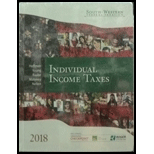
South-western Federal Taxation 2018: Individual Income Taxes
41st Edition
ISBN: 9781337385886
Author: William H. Hoffman, James C. Young, William A. Raabe, David M. Maloney, Annette Nellen
Publisher: Cengage Learning
expand_more
expand_more
format_list_bulleted
Question
Chapter 7, Problem 14DQ
To determine
Find out the relevant tax issues for person J.
Expert Solution & Answer
Want to see the full answer?
Check out a sample textbook solution
Students have asked these similar questions
Hello tutor please help me with accounting questions
Subject general accounting
Don't use ai given answer accounting questions
Chapter 7 Solutions
South-western Federal Taxation 2018: Individual Income Taxes
Ch. 7 - Prob. 1DQCh. 7 - Prob. 2DQCh. 7 - Prob. 3DQCh. 7 - Prob. 4DQCh. 7 - Many years ago, Jack purchased 400shares of Canary...Ch. 7 - Scan is in the business of buying and selling...Ch. 7 - Prob. 7DQCh. 7 - Prob. 8DQCh. 7 - Prob. 9DQCh. 7 - Prob. 10DQ
Ch. 7 - Prob. 11DQCh. 7 - Prob. 12DQCh. 7 - Prob. 13DQCh. 7 - Prob. 14DQCh. 7 - Prob. 15DQCh. 7 - Prob. 16DQCh. 7 - Prob. 17DQCh. 7 - Prob. 18DQCh. 7 - Prob. 19DQCh. 7 - Prob. 20DQCh. 7 - Last year Aleshia identified 15,000 as a...Ch. 7 - Prob. 22CECh. 7 - Prob. 23CECh. 7 - Prob. 24CECh. 7 - Prob. 25CECh. 7 - Prob. 26CECh. 7 - Prob. 27CECh. 7 - Prob. 28CECh. 7 - Prob. 29CECh. 7 - Prob. 30CECh. 7 - Prob. 31CECh. 7 - Prob. 32PCh. 7 - Monty loaned his friend Ned 20,000 three years...Ch. 7 - Sally is in the business of purchasing accounts...Ch. 7 - Prob. 35PCh. 7 - Prob. 36PCh. 7 - Prob. 37PCh. 7 - Prob. 38PCh. 7 - Prob. 39PCh. 7 - Prob. 40PCh. 7 - Prob. 41PCh. 7 - Prob. 42PCh. 7 - Prob. 43PCh. 7 - Prob. 44PCh. 7 - Prob. 45PCh. 7 - Prob. 46PCh. 7 - Prob. 47PCh. 7 - Prob. 48PCh. 7 - Prob. 49PCh. 7 - Prob. 50PCh. 7 - Prob. 51PCh. 7 - Prob. 52PCh. 7 - Prob. 53CPCh. 7 - Prob. 54CPCh. 7 - Prob. 1RPCh. 7 - Prob. 2RP
Knowledge Booster
Similar questions
- Provide accurate Answerarrow_forwardSummit Corporation's activity-based costing system has three activity cost pools: Machining, Assembling, and Other. The company's overhead costs have already been allocated as follows: Machining: $9,500 Assembling: $42,500 Other: $18,000 Costs in the Machining cost pool are assigned to products based on machine hours (MHS), and costs in the Assembling cost pool are assigned to products based on the number of assembly operations. Costs in the Other cost pool are not assigned to products. The company has two products, Product X and Product Y. The following data represent their respective machine hours and assembly operations: Product X: 8,000 machine hours, 300 assembly operations Product Y: 12,000 machine hours, 700 assembly operations Total: 20,000 machine hours, 1,000 assembly operations Required: Calculate activity rates for the Machining and Assembling activity cost pools using activity-based costing.arrow_forwardSolve this General accounting problemarrow_forward
- LMT Corporation manufactures and sells a product called Product ZX. Each unit of Product ZX requires 2.5 hours of direct labor at the rate of $20.00 per direct labor hour. The company plans to sell 38,000 units of Product ZX in July. The finished goods inventories on July 1 and July 31 are budgeted to be 720 and 220 units, respectively. Budgeted direct labor costs for July would be __. Correct answerarrow_forwardWhat would Their revenue need to be for their account to be in balance?arrow_forwardHi expert please give me answer general accounting questionarrow_forward
arrow_back_ios
SEE MORE QUESTIONS
arrow_forward_ios
Recommended textbooks for you
 Individual Income TaxesAccountingISBN:9780357109731Author:HoffmanPublisher:CENGAGE LEARNING - CONSIGNMENT
Individual Income TaxesAccountingISBN:9780357109731Author:HoffmanPublisher:CENGAGE LEARNING - CONSIGNMENT



Individual Income Taxes
Accounting
ISBN:9780357109731
Author:Hoffman
Publisher:CENGAGE LEARNING - CONSIGNMENT


